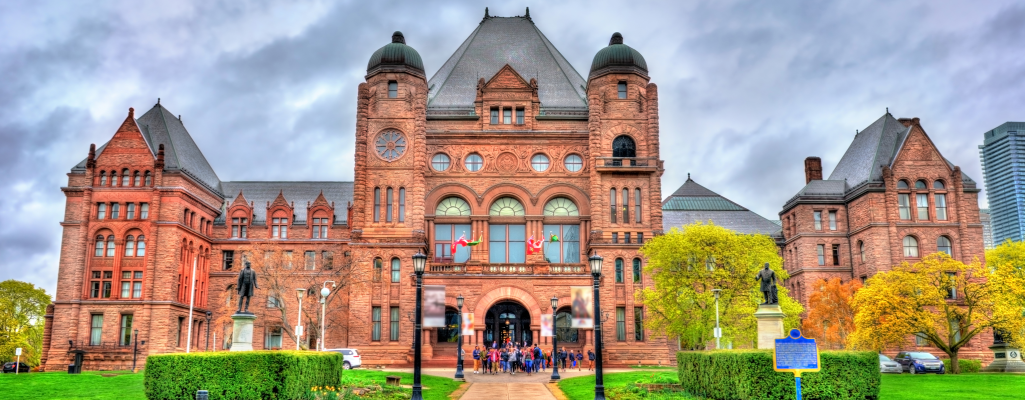
RNAO's Provincial Election Platform
NURSES VOTE:
RNAO's provincial election platform
Pillars: NURSING | HEALTH CARE | SOCIAL DETERMINANTS OF HEALTH | ENVIRONMENTAL DETERMINANTS OF HEALTH | FISCAL CAPACITY AND INCOME AND WEALTH INEQUALITY
Resources: Media release
Feb. 27, 2025 marks Ontario’s provincial election. Elections matter – and every vote counts.
To inform Ontarians about nurses’ priorities for the upcoming provincial election, RNAO has released its provincial election platform. Nurses form the backbone of a society that values holistic health and wellbeing, and a thriving nursing profession is indispensable to a thriving health-care system. Nurses understand that health and wellbeing are inseparable from the conditions in which we live, work, and play. Ontarians’ lives are shaped not only by access to health care but also by the broader social, economic, and environmental determinants of health – including recent and unprecedented threats of a potential trade war by the U.S. president.
RNAO urges every nurse, their families and the public to actively engage in the democratic process. Voting is both a right and a responsibility. We encourage you to participate, ask critical questions and challenge political candidates. A strong democracy is foundational to a healthy society, and – together – we can work to protect and strengthen it.


NURSING
Address the nursing crisis by implementing measures to retain and recruit registered nurses and nurse practitioners, while ensuring healthy and supportive work environments.
- Guarantee competitive compensation for nurses comparable to other jurisdictions, such as the United States.
- Harmonize pay upwards to tackle disparities in primary care, home care and long-term care.
- Increase nurse staffing and support across all health-care sectors to ensure safe workloads.
- Expand full-time roles, reduce reliance on agency and casual workers, and phase out the use of private for-profit nurse staffing agencies by 2027.
- Prevent deskilling of the nursing workforce, such as replacing regulated with unregulated staff.
- Expand registered nurse (RN) scope, including embedding RN prescribing in all Bachelor of Science in Nursing (BScN) curriculum by 2027, and:
- For those nurses who have already graduated, provide tuition support for RN prescribing to prepare up to 20,000 RNs as prescribers over four years.
- Expand nurse practitioner (NP) scope, including the ability to initiate mental health services under the Mental Health Act, and to achieve full potential in primary care.
- Increase funding for continuing education, professional development, specialty certifications and leadership training.
- Strengthen mentorship and retention programs such as the Nursing Graduate Guarantee, Late Career Nurse Initiative, and implement a Return to Nursing Now program for nurses who have left the workforce to re-enter practice.
- Expand access to primary care by increasing the number of seats in NP programs, starting with 200 additional seats in 2025, aiming to reach 7,500 registered NPs in Ontario by 2029 to address the growing number of Ontarians without a regular primary care provider.
- Expand seats in BScN programs – including four-year and compressed BScN, second-entry, and bridging programs – starting with 1,000 additional seats in 2025, followed by annual 10 per cent increases for three years, with the goal of registering 10,000 new Ontario RNs by 2029.
- Continue to support internationally educated nurses (IEN) residing in Canada while maintaining the BScN as the entry to practice and ban active international recruitment ("poaching").
- Recruit and retain faculty for nursing programs and promote funding for PhD in Nursing and Doctor of Nursing.
- Introduce funding to develop paid post-graduate NP residency programs to improve access to specialized care for Ontarians.
- Integrate retention and recruitment strategies into a comprehensive health human resources interprofessional plan led by the Ontario ministry of health.
- Address racism and all other forms of discrimination. Promote equity, diversity, and inclusion (EDI) in all workplaces and in nursing education, professional development, career advancement and mentorship.
- Address workplace violence, staff mental health, staff wellness, and occupational health and safety with robust policies and support.

HEALTH CARE
Ensure a health system that is accessible, equitable, person-centred, integrated, not-for-profit and publicly funded.
- Develop a health system that is accessible, equitable, person-centred, integrated, not-for-profit and publicly funded.
- Reduce costs and shorten wait times by reversing the shift toward for-profit health care, reintegrating investor-driven clinics into the public system, and redirecting funding to strengthen public institutions.
- Provide adequate funding to hospitals to ensure reasonable wait times for emergency services, and clear surgery, treatment, and procedure backlogs safely and promptly without resorting to for-profit care.
- Increase the funding for an additional 500 RN First Assistant and 200 NP anesthetists by 2029 to prevent delays in surgical procedures and to reduce wait times.
- Collaborate with the federal government to broaden the Canadian Dental Care Plan.
- Finalize an agreement with the federal government on pharmacare and collaborate in its expansion beyond diabetes and contraception.
- Expand publicly funded, not-for-profit mental health services, including harm reduction and treatment sites, and address substance use and addiction as public health emergencies.
- Ensure that Public Health Ontario has sustainable resources required to deliver on the agency’s mandate effectively, including emergency preparedness, by reallocating one-time annual funding to base funding and indexing to inflation. Protect the independence of medical officers of health and Public Health Ontario.
- Adopt the Enhancing Community Care for Ontarians (ECCO) model aiming to anchor the health system in primary care, including:
- Anchoring Ontario Health Teams (OHT) in primary care with stronger links to social services, public health, and mental health supports, ensuring community engagement and funding alignment.
- Tackling system-wide challenges, including overreliance on hospitals, underutilization of primary and home care, and unmet needs of vulnerable populations.
- Shifting care delivery to home and community settings to improve outcomes and cost-effectiveness.
- Amend “Roadmap to Wellness” to incorporate 500 RN psychotherapists by 2029, allocating public funds to support access across Ontario.
- Increase funding for pediatric care across all sectors, especially in primary care and home care.
- Attach 3.0 million people without a regular care provider to an NP or family doctor by 2029.
- Ensure primary care providers work in interprofessional care teams that include nurses, and other health professionals, as well as social services.
- Fund a minimum of 54 NP-led clinics by 2029.
- Develop and implement a publicly funded model for independent NPs in primary care, ensuring no user-fees, with a focus on serving smaller communities.
- Fulfil the existing government commitment for new NP positions to deliver primary care in correctional facilities.
- Increase access to robust, integrated home and community care services by supporting an expanded publicly‐funded basket of services.
- Scale and support models of home care within OHTs that facilitate integration between home care and other sectors.
- Reform the funding model for home care services from transactional per-visit basis to relational care. This means funding baskets to allow a person-centred approach that encompasses a range of nursing interventions, including health promotion and ensuring continuity of care and continuity of caregiver.
- Reduce the wait list for long-term care (LTC) through not-for-profit LTC expansion.
- Implement RNAO’s Nursing Home Basic Care Guarantee to ensure at least four hours of direct care daily per long-term care (LTC) resident, with a skill mix of 20 per cent RNs, 25 per cent registered practical nurses, and 55 per cent personal support workers by 2028.
- Increase the funding for Attending NPs as most responsible care providers in LTC, ensuring all homes have achieved one NP per 120 residents by 2028.
- Fund NPs to act as clinical directors so LTC homes can have a medical doctor or an NP in this role, ensuring quality of life for residents and optimized outcomes.
- Mandate one RN specializing in infection prevention and control per 120 residents.
- Fund delivery of one hour of daily care per resident from interprofessional staff such as physiotherapy, rehabilitation therapy, recreational care, speech therapy, social work, dietary, and dental care.
- Ensure safe and quality care by prioritizing regulated health professionals and banning deskilling practices, such as allowing unregulated workers to administer medications.
- Change the LTC funding formula to allow LTC homes that decrease acuity (Case Mix Index) by implementing evidence-based care to retain all funding to reinvest in staffing and/or programs for residents.
- Expand the funding to digitally integrate best practice guidelines into care for nursing home residents.
- Secure funding to develop and administer a Dementia Care Centre of Excellence to promote the delivery of evidence-based and compassionate care.

SOCIAL DETERMINANTS OF HEALTH
Strengthen the social determinants of health by improving access to housing, education, and fostering healthy, equitable, diverse and inclusive communities.
- Promote development of affordable, accessible, multi-storied, multi-unit housing, lowering costs through modular building and new technology, while protecting farmland and natural spaces.
- Invest one per cent of the provincial budget in non-market housing (e.g., owned and operated by a government agency or non-profit organization).
- Strengthen tenant rights, cap rent increases below the consumer price index and limit availability of above-guideline rent increases.
- Implement these and other measures in a comprehensive homelessness strategy that includes supportive housing, shelters and wrap-around services.
- Invest in public schools, enhance working conditions for education workers, reduce class sizes, and address infrastructure backlogs.
- Support in-person rather than online learning, foster inclusive and welcoming school environments, and prioritize students’ mental wellbeing.
- Make tuition affordable for all by implementing a sliding-scale tuition model, strengthening the Ontario Student Assistance Program (OSAP), tackling post-graduation debt, and guaranteeing adequate funding for colleges and universities.
- Develop public spaces such as parks, libraries, and community centres while supporting local initiatives such as food security programs, neighbourhood revitalization and cultural preservation.
- Invest in public transit and “active” transit such as bike lanes to provide affordable, accessible and environmentally sustainable mobility options.
- Expand mental health care and crisis intervention (non-police) programs and address the toxic drug crisis with harm reduction strategies.
- Withdraw the plan to close supervised consumption sites (SCS) and provide funding for expansion of harm reduction and treatment services across the province.
- Invest in preventative community safety programs and implement a human rights approach – not a policing and criminalizing approach – to homelessness, mental health, substance use and addiction, and to other discriminated groups in society.
- Truth and reconciliation:
- Implement the National Truth and Reconciliation Commission’s Calls to Action.
- Fund initiatives addressing Missing and Murdered Indigenous Women and Girls and fulfil related Calls for Justice.
- Uphold the United Nations Declaration on the Rights of Indigenous Peoples, including land and resource rights, access to clean water, health care and housing.
- Indigenous economic development:
- Support Indigenous-owned businesses, infrastructure projects, land claims, training and job creation initiatives.
- Encourage partnerships with Indigenous communities and respect free, prior and informed consent for natural resource management.
- Relationship-building:
- Strengthen nation-to-nation relationships and Indigenous governance capacity.
- Advance restorative justice through community-led programs.
- Gender equity:
- Apply a gender-equity lens to all government policy.
- Broaden the $10-a-day National Daycare Plan with federal collaboration.
- Tackle gender-based violence – including intimate partner violence – and expand opportunities for women in leadership roles.
- Anti-racism and anti-oppression:
- Tackle systemic racism with public sector reforms and mandatory training.
- End the overrepresentation of Black and Indigenous children in care and adults in prisons.
- Promote community-led initiatives advancing equity, diversity and inclusion (EDI) for marginalized populations.
- Inclusion for 2SLGBTQI+ people:
- Deliver equitable care, including gender-affirming services and support for trans and queer youth.
- Promote public education on 2SLGBTQI+ inclusion.
- Mandate all-gender washrooms in public spaces.
- Inclusion for people with disabilities:
- Address the needs of children with disabilities, such as reducing waitlists for autism services.
- Fund therapeutic and respite services, assistive devices and housing retrofits.
- Implement and enhance the Accessibility for Ontarians with Disabilities Act.
- Increase income support entitlements – for example, Ontario Disability Support Program benefits – to reflect the cost of living.
- Collaborate with other jurisdictions to regulate social media and AI, to prevent harm to mental health, social cohesion and democracy.
- Educate the public through literacy programs emphasizing responsible digital use and critical thinking, with a focus on issues such as addiction, cyberbullying, misinformation and disinformation, hate speech, and algorithmic bias.
- Require platforms to disclose how algorithms influence user behaviour, addressing issues such as addiction, cyberbullying, misinformation, hate speech, and algorithmic bias.
- Shift platforms away from business models that profit from clickbait, outrage, and extremism.
- Strengthen protections for children by enforcing data privacy and implementing age-specific safeguards.

ENVIRONMENTAL DETERMINANTS OF HEALTH
Improve health outcomes by building a low-carbon, just, and equitable economy, phasing-out fossil fuels, and addressing pollution.
- Phase out fossil fuels and lead a just transition to renewable and low-carbon industries, prioritizing job creation and community support.
- Set emissions reduction targets aligned with international commitments, aiming to reduce emissions by 40-45 per cent below 2019 levels by the year 2029 and to achieve net-zero by 2050.
- Mandate large public and private institutions, including financial organizations, to disclose climate impacts and achieve emission reductions.
- Collaborate with the federal government on carbon pricing and other national environmental policies.
- Phase out gas-powered plants and increase investment in renewable energy rather than nuclear power.
- Promote dense, liveable neighbourhoods that prioritize walking and cycling over car dependency.
- Enhance sustainable transportation by expanding public transit, promoting electric vehicles, and halting plans for new highway expansions.
- Retrofit homes for energy efficiency and set stringent emission standards for new buildings, including a ban on new natural gas hookups.
- Collaborate with the federal government on a national climate adaptation strategy.
- Support municipal climate action plans and invest in climate-resilient infrastructure to address extreme weather events.
- Protect the Greenbelt, wetlands, forests, and farmland by stopping urban sprawl and unchecked development.
- Restore rigorous environmental assessments, the independence of provincial conservation authorities, and protections for species at risk.
- Protect water sources, including by banning bulk water removals and regulating harmful pollutants.
- Reduce plastic waste through expanded producer responsibility, enhanced recycling standards, bans on single-use plastics, and deposit-return systems for beverages.
- Protect vulnerable communities, including Indigenous and racialized groups, from environmental harm and ensure equitable access to clean and safe environments.

INCREASING FISCAL CAPACITY AND REDUCING INCOME AND WEALTH INEQUALITY
Strengthen fiscal capacity through fair taxation and income measures that reduce extreme income and wealth inequality in society.
- Collaborate with the federal government on fiscal, tax and anti-poverty reforms, with the purpose of enacting the measures listed below, including ensuring equitable transfer payments to Ontario.
- Introduce additional tax brackets for incomes of more than $250,000 per year to ensure fair contributions from high earners.
- Implement a wealth tax on net assets exceeding $10 million and an inheritance tax on estates over $5 million to address wealth inequality.
- Tax capital gains at the same rate as employment income to eliminate preferential treatment of wealth-derived income.
- Expand luxury taxes to include high-end goods such as private jets, luxury cars, mansions and yachts.
- Close tax loopholes and address corporate tax avoidance strategies involving tax havens and offshore accounts.
- Offer targeted tax incentives to small businesses that prioritize job creation and pay living wages.
- Enforce polluter-pay taxes on environmentally harmful goods, with rebates provided to low-income households to offset costs.
- Remove HST from essential items such as children’s clothing and menstrual products.
- Guarantee fiscal transparency by ensuring taxpayers have access to clear information on how revenues are spent.
- Strengthen support for vulnerable populations by introducing a provincial supplement to federal programs like the Canada Child Benefit and Guaranteed Income Supplement.
- Enhance retirement security by introducing a provincial supplement to federal programs like the Canada Pension Plan and Old Age Security.
- Progress toward a Guaranteed Basic Income based on lessons learned from Ontario’s previous Basic Income Pilot Project.
- Immediately double benefit levels in Ontario Works (OW) and Ontario Disability Support Program (ODSP) to reflect the cost of living and index them to inflation, and:
- Enhance health-related supports within these programs.
- Improve access to training, job placements, and workplace accommodations for recipients.
- Reduce income clawback and support recipients in transitioning to employment.
- Align the minimum wage with Ontario’s cost of living to ensure it reflects a real living wage.
- Provide supports for small businesses and non-profits to help them adapt to increased labour costs.
- Guarantee fair wages, predictable schedules and access to benefits and pensions for part-time, temporary and other precarious workers.
- Simplify unionization processes and strengthen collective bargaining rights to address workplace inequities.
- Guarantee a minimum number of paid sick days for all workers to reduce financial strain when ill and safeguard public health.
- Strengthen workplace safety enforcement and protection against harassment, discrimination and unsafe conditions.
Voter information
Visit elections.on.ca to find voter information such as your riding, riding map, where to vote, and more.
